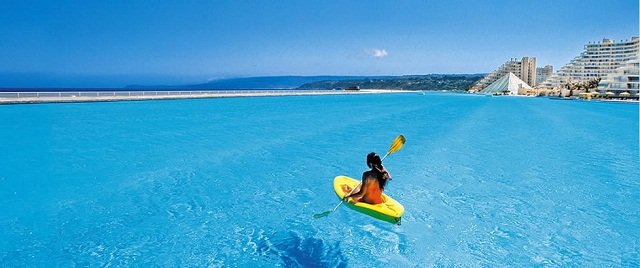Crystal Lagoons technology can be acquired through a franchise for each project, which includes the license to use the patented technology and the know-how necessary for the correct implementation of the project. Crystal Lagoons charges a royalty for this franchise, which is equivalent to a small percentage of the sales from the project, therefore collecting only a small portion of the tremendous value that this concept and technology adds to any project.
How much are the maintenance costs for the lagoon? What do the Crystal Lagoons include?
The great advantage of this concept and technology is that it can be implemented at very low maintenance costs. The maintenance costs are approximately US$ 4,000 per hectare (US$ 1,600 per acre) per month including energy, labor and additives.
How much are the construction costs for a Crystal Lagoon?
One of the great values of Crystal Lagoons‘ concept and technology is that it can be implemented at very low construction costs: Construction costs are approximately US$ 400,000 per hectare (US$ 160,000 per acre) for a standard 5 hectare lagoon. This figure does not include the cost of earth movement and related work.
What is the energy consumption of a Crystal Lagoon?
The Crystal Lagoons‘ Technology consumes just 2% of the energy needed for conventional filtration systems, making this technology low-cost and sustainable. The lagoons use 100 times less chemical products than conventional swimming pool systems. This makes Crystal Lagoons‘ concept and technology ecological and safe. Crystal Lagoons technology works equally well with salt, fresh and brackish water. Today, we have lagoons in operation with all types of water.
Rainwater does not have any negative impact on the lagoons. However, consideration should be given to the location of the lagoon and its surrounding buildings to prevent rainwater from draining into the lagoon. These issues are common to all projects and Crystal Lagoons‘ team has extensive experience with them.
What are the effects of organic compounds (leaves, cut grass, etc.), and also dirt and atmospheric dust blown by the wind?
Architectural, construction and landscaping features can be used to prevent organic compounds (leaves, cut grass, etc.), dirt and atmospheric dust from entering the lagoon, either due to their proximity to the lagoon or because they are blown by the wind. However, this is not due to a technical requirement, but rather to avoid the need for additional manpower to remove these elements from the lagoon.
Crystal Lagoons company recommends constructing lagoons with a surface area of at least 3 hectares (7 acres) to allow for sailing and water sports in a colossal, unique and impressive body of water, thereby adding incalculable value to the project. Furthermore, the construction and maintenance costs of these lagoons are so low that achieving giant, crystalline bodies of water is economically viable. Although smaller lagoons are possible based on the specifications of each project.
How deep are the lagoons made by Crystal Lagoons?
The lagoons can be constructed to any depth. However, we recommend that some sectors of the lagoon have a minimum of 2.4 m (8 ft). Within this depth range the intense blue turquoise color can be achieved; this also avoids the tendency for people to walk in the lagoon, which might interfere with water sports.
How is the Crystal Lagoon’s water quality controlled?
The lagoon’s hydraulic, biochemical and mechanical systems are monitored, controlled and operated remotely by Crystal Lagoons from our control centers. This ensures that water quality is maintained within our established parameters, guaranteeing high, standardized quality no matter where in the world the lagoon is located.
How much water does the lagoon consume?
Crystal Lagoons concept and technology means our lagoons consume very little water. They work on a closed circuit in which it is only necessary to compensate for evaporation. One hectare of lagoon consumes 50% less water than a conventional park, while a 3 hectare (7 acre) lagoon consumes up to 10 times less water than a golf course.


